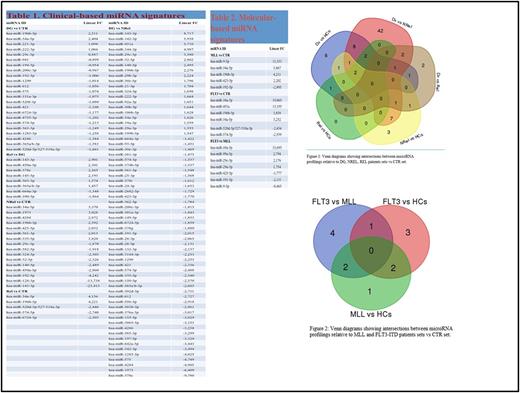Abstract
Background
Despite recent progresses in the treatment of childhood AML, the outcome of high-risk patients (carrying selected molecular aberrations and/or having high levels of minimal residual disease at the end of therapy) remains dismal. In particular, patients harboring FLT3-ITD or some translocations involving MLL (such as MLL-AF10 or MLL AF4) still have a poor prognosis, mainly due to leukemia recurrence.
A key feature of FLT3-ITD and MLL-rearranged leukemia is cMYC overexpression, a well-known oncogene often involved in cancer. JQ1 is a BET inhibitor, preventing cMYC expression through the binding to the BET bromodomain protein, BRD4. Moreover, Curcumin is a compound able to induce epigenetic changes, including inhibition of histone-acetyltransferases (HATs), resulting in a decrease of acetylated lysine residues, a target for BRD4 bound on DNA.
Aim
We evaluated whether the combination of JQ1 and Curcumin has a potential synergic effect on AML cell lines or primary blasts harboring FLT3-ITD and MLL-rearrangement. These experimental data could be instrumental for developing novel treatment options alternative or complementary to standard chemotherapy.
Methods
Cell lines with FLT3-ITD and/or MLL fusion proteins used in this study were: MV-4-11, THP1, MOLM-13 and RS-4-11 [ALL cell line harboring t(4;11)]. Cells were all treated with JQ1 [250nM], while the dose of Curcumin varied according to the MLL-rearrangement (5μM for MV-4-11 and RS-4-11 carrying MLL-AF4 rearrangement and 10μM for THP1 and MOLM-13 harboring MLL-AF9 rearrangement). After 48 hours of either single-drug or combined treatment (J+C), western blot, XTT assay, RT-qPCR and Annexin V FACS analysis were carried out to assess proliferation rates, apoptosis and expression of their related genes, as well as the expression of cMYC and AcH3K14. Capacity to form colonies after either single or combined drug exposure was tested on bone marrow derived CD34+ cells from 4 patients with either MLL-rearranged acute leukemia (AML MLL-AF9; ALL MLL-AF4; AML MLL-AF4) or FLT3-ITD using Methocult media.
miRNA expression profile of 20 BM samples of either FLT3-ITD or MLL-rearranged AML collected at both diagnosis (Dx) and at relapse (Rel) was assessed with Nanostring platform. Results were compared with those obtained analyzing BM samples of 8 healthy controls (HCs) and of 12 patients with the same molecular lesions who did not relapse (NRel). Expression levels of the modulated miRNAs were also evaluated on the cell lines reported above. A supplemental miRNA profiling analysis was conducted comparing cells harboring FLT3-ITD with those carrying MLL-rearrangements with respect to HCs.
Results
In comparison with treatment with either of the 2 agents, the J+C combination resulted into to a synergic effect on apoptosis rate of MOLM-13 cells and of RS-4-11 cells. In particular, the apoptosis rates of the former cell line were 16% with JQ1, 10% with Curcumin and 56% with J+C, while those of the latter cell line were 20% with JQ1, 4% with Curcumin and 52% with J+C, respectively. The XTT metabolic assay showed significant reduction in 24 and 72-hour proliferation rates after both single-agent and combined treatments in all cell lines compared to DMSO (2WayANOVA; P<0.05)
RT-qPCR and western blot experiments showed an increased expression of BCL2, cleaved CASPASE-3, cleaved PARP1 and p21 levels, as well as a decrease of cMYC and AcH3K14. Single-agent and combined treatment also resulted into a significant decrease of number of colonies in all the 4 primary cultured patient blasts (Fisher's exact t-test; P<0.05). 118 miRNAs were found to be significantly modulated in samples of Rel and NRel groups compared with those of HCs, while 18 miRNAs were found to be modulated in either MLL-rearranged or FLT3-ITD AML as described in the Figure1, 2, and Table 1, 2. We also noticed an opposite expression trend for miR-99 and miR-34a in MLL-AF4 AML and MLL-AF9 AML, and significant modulations of expression after single-agent and J+C treatment for miR-99, miR-34a, miR-451 and miR-196a in our cell lines.
Conclusions
Our data demonstrate that J+C exert an intense synergic effect on AML cell lines and primary blasts, leading to increased apoptosis, reduced proliferation rate, modulation in expression of some key genes, such as cMYC, BCL2 and AcH3K14. We also identified distinct miRNA signatures in patients collected at relapse as compared to those obtained at diagnosis or HCs.
No relevant conflicts of interest to declare.
Author notes
Asterisk with author names denotes non-ASH members.


This feature is available to Subscribers Only
Sign In or Create an Account Close Modal